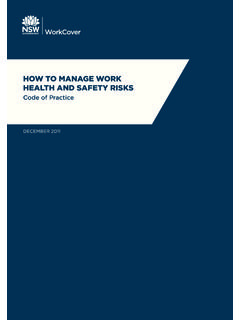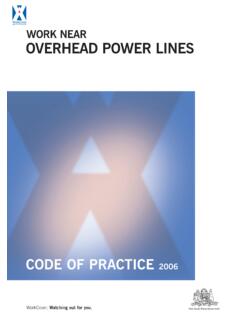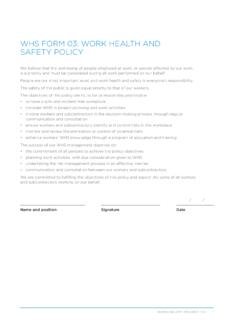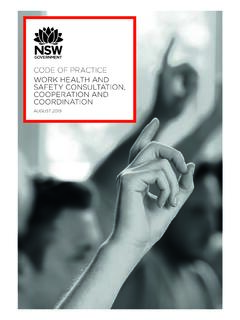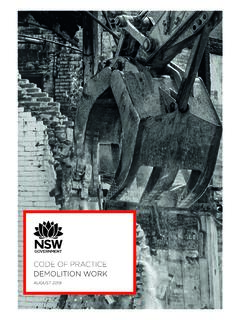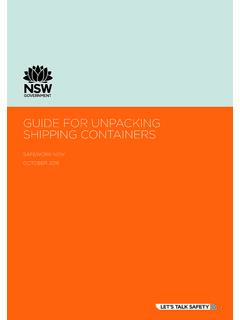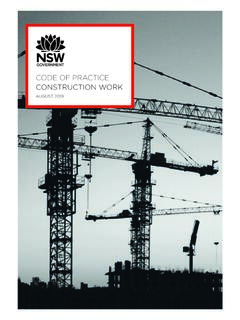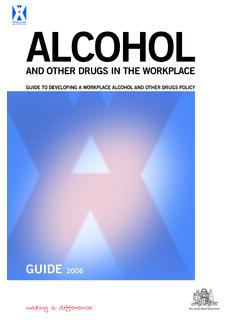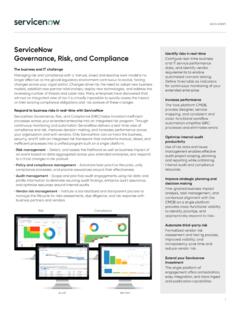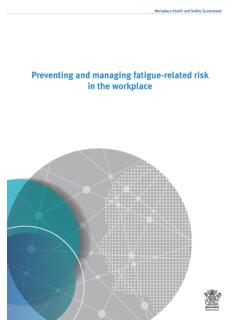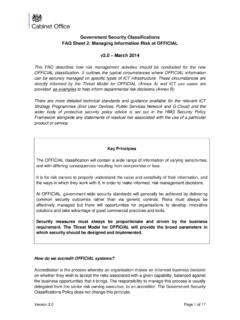Transcription of CODE OF PRACTICE - SafeWork NSW
1 CODE OF PRACTICEMANAGING THE RISKS OF PLANT IN THE WORKPLACEAUGUST 2019 NSW note: This code is based on a national model code of PRACTICE developed by Safe Work Australia under the harmonisation of national work health and safety legislation and has been approved under section 274 of the NSW Work Health and Safety Act 2011. Notice of that approval was published in the NSW Government Gazette referring to this code of PRACTICE as managing the risks of plant in the workplace (page 2695) on Friday 18 July 2014. This code of PRACTICE commenced on Friday 18 July amendments under section 274 of the NSW Work Health and Safety Act 2011 have been published and commenced as detailed in the list of amendments contained in this for the NSW Government logo, this copyright work is licensed under a Creative Commons Attribution-Non-Commercial Australia view a copy of this licence, visit are free to copy, communicate and adapt the work for non-commercial purposes, as long as you attribute the work to SafeWork NSW and abide by the other licence terms.
2 Contents Foreword .. 4 1. Introduction .. 5 What is plant ? .. 5 Who has health and safety duties for plant at the workplace? .. 5 What is involved in managing risks associated with plant? .. 8 Information, training, instruction and supervision .. 11 Registering plant .. 12 2. The risk management process .. 13 Identifying the hazards .. 13 Assessing the risks .. 15 Controlling the risks .. 16 Maintaining and reviewing control measures .. 19 3. Controlling risks: from purchase to disposal .. 20 Purchasing and hiring plant .. 20 Installation and commissioning of plant .. 23 Using plant in the workplace .. 25 Making changes .. 26 Inspecting plant .. 27 Maintenance, repair and cleaning of plant .. 28 Storing plant .. 29 Decommissioning, dismantling and disposing of plant .. 31 4. Specific control measures .. 32 Guarding plant .. 32 Operational controls .. 39 Emergency stops .. 39 Warning devices .. 41 Isolating energy sources.
3 42 5. Plant registration .. 45 Design and altered design registration .. 45 Item registration .. 46 6. Keeping records .. 48 Record keeping plant .. 48 Appendix A Glossary .. 49 Appendix B Registrable plant designs and items of plant .. 52 Appendix C Hazard 54 Appendix D Examples of technical standards .. 57 Amendments .. 65 managing the risks of plant in the workplace Code of PRACTICE Page 4 of 66 Foreword This Code of PRACTICE on how to manage risks of plant in the workplace is an approved code of PRACTICE under section 274 of the Work Health and Safety Act (the WHS Act). An approved code of PRACTICE provides practical guidance on how to achieve the standards of work health and safety required under the WHS Act and the Work Health and Safety Regulation (the WHS Regulation) and effective ways to identify and manage risks. A code of PRACTICE can assist anyone who has a duty of care in the circumstances described in the code of PRACTICE . Following an approved code of PRACTICE will assist the duty holder to achieve compliance with the health and safety duties in the WHS Act and WHS Regulation, in relation to the subject matter of the code of PRACTICE .
4 Like regulations, codes of PRACTICE deal with particular issues and may not cover all relevant hazards or risks. The health and safety duties require duty holders to consider all risks associated with work, not only those for which regulations and codes of PRACTICE exist. Codes of PRACTICE are admissible in court proceedings under the WHS Act and WHS Regulation. Courts may regard a code of PRACTICE as evidence of what is known about a hazard, risk, risk assessment or risk control and may rely on the code in determining what is reasonably practicable in the circumstances to which the code of PRACTICE relates. For further information see the Interpretive Guideline: The meaning of reasonably practicable . Compliance with the WHS Act and WHS Regulation may be achieved by following another method if it provides an equivalent or higher standard of work health and safety than the code. An inspector may refer to an approved code of PRACTICE when issuing an improvement or prohibition notice.
5 Scope and application This Code is intended to be read by a person conducting a business or undertaking (PCBU). It provides practical guidance to PCBUs on how to manage health and safety risks associated with managing risks of plant in the workplace. This Code may be a useful reference for other persons interested in the duties under the WHS Act and WHS Regulation. This Code applies to all workplaces covered by the WHS Act and WHS Regulation where plant is operated and where plant equipment is used or stored. Further information is available in Safe Work Australia s Guidance material for the safe design, manufacture, import and supply of plant. How to use this Code of PRACTICE This Code includes references to the legal requirements under the WHS Act and WHS Regulation. These are included for convenience only and should not be relied on in place of the full text of the WHS Act or WHS Regulation. The words must , requires or mandatory indicate a legal requirement exists that must be complied with.
6 The word should is used in this Code to indicate a recommended course of action, while may is used to indicate an optional course of action. managing the risks of plant in the workplace Code of PRACTICE Page 5 of 66 1. Introduction What is plant ? Plant includes machinery, equipment, appliances, containers, implements and tools and any components or anything fitted or connected to those things. Plant includes items as diverse as lifts, cranes, computers, machinery, conveyors, forklifts, vehicles, power tools, quad bikes, mobile plant and amusement devices. The general duty of care under the WHS Act applies to this type of plant. Plant that relies exclusively on manual power for its operation and is designed to be primarily supported by hand, for example a screwdriver, is not covered by the WHS Regulation. Plant is a major cause of work-related death and injury in Australian workplaces. There are significant risks associated with using plant and severe injuries can result from the unsafe use of plant including: limbs amputated by unguarded moving parts of machines being crushed by mobile plant sustaining fractures from falls while accessing, operating or maintaining plant being crushed by a quad bike rollover electric shock from plant that is not adequately protected or isolated, and burns or scalds due to contact with hot surfaces, or exposure to flames or hot fluids.
7 Other risks include hearing loss due to noisy plant and musculoskeletal disorders caused by manually handling or operating poorly designed plant. Who has health and safety duties for plant at the workplace? There are a number of duty holders who have a role in managing the risks of plant in the workplace. These include: persons conducting a business or undertaking (PCBUs) PCBU involving the management or control of fixtures, fittings or plant designers, manufacturers, importers and suppliers of plant, substances or structures installers, and officers. Workers and other persons at the workplace also have duties under the WHS Act, such as the duty to take reasonable care for their own health and safety at the workplace. A person can have more than one duty and more than one person can have the same duty at the same time. Early consultation and identification of risks can allow for more options to eliminate or minimise risks and reduce the associated costs.
8 managing the risks of plant in the workplace Code of PRACTICE Page 6 of 66 Person conducting a business or undertaking WHS Act section 19 Primary duty of care A PCBU must eliminate risks arising from plant in the workplace, or if that is not reasonably practicable, minimise the risks so far as is reasonably practicable. The WHS Regulation includes more specific requirements for PCBUs to manage the risks of hazardous chemicals, airborne contaminants and plant, as well as other hazards associated with the workplace. This duty includes ensuring, so far as is reasonably practicable: the provision and maintenance of safe plant, and the safe use, handling, storage and transport of plant. PCBUs have a duty to consult workers about work health and safety and may also have duties to consult, cooperate and coordinate with other duty holders. Persons who conduct a business or undertaking involving the management or control of fixtures, fittings or plant WHS Regulation clause 203 Management of risks to health and safety WHS Regulation clause 204 Control of risks arising from installation or commissioning WHS Regulation clause 205 Preventing unauthorised alterations to or interference with plant WHS Regulation clause 206 Proper use of plant and controls WHS Regulation clause 207 Plant not in use WHS Regulation clause 208 Guarding WHS Regulation clause 209 Guarding and insulation from heat and cold WHS Regulation clause 210 Operational controls WHS Regulation clause 211 Emergency stops WHS Regulation clause 212 Warning devices WHS Regulation clause 213 Maintenance and inspection of plant managing the risks of plant in the workplace Code of PRACTICE Page 7 of 66 Multiple duties The WHS Regulation includes specific duties for PCBUs involving the management or control of plant including requirements to.
9 Manage the health and safety risks associated with plant prevent unauthorised alterations to or interference with plant, and use plant only for the purpose for which it was designed unless the proposed use does not increase the risk to health or safety. There are generally a number of people involved with plant during its lifecycle. For example, different people will be involved from its design through to its use and eventual disposal, and throughout this process a person can have more than one duty and more than one person can have the same duty at the same time. For example, if you own and operate plant in your workplace and you decide to modify it yourself, you will have the duties of a designer and manufacturer as well as a person with management or control of plant at the workplace. Further information is available in SWA s Guidance material for the safe design, manufacture, import and supply of plant. Designers, manufacturers, importers and suppliers of plant, substances or structures WHS Act section 22 Duties of persons conducting businesses or undertakings that design plant, substances or structures WHS Act section 23 Duties of persons conducting business or undertakings that manufacture plant, substances or structures WHS Act section 24 Duties of persons conducting businesses or undertakings that import plant, substances or structures WHS Act section 25 Duties of persons conducting businesses or undertakings that supply plant, substances or structures WHS Act section 26 Duties of persons conducting businesses or undertakings that install, construct or commission plant or structures Designers, manufacturers, importers and suppliers of plant, substances or structures must ensure, so far as is reasonably practicable, the plant, substances or structure they design, manufacture, import or supply is without risks to health and safety.
10 This duty includes carrying out testing and analysis as well as providing specific information about the plant or substance. To assist in meeting these duties, the WHS Regulation requires: manufacturers to consult with designers of the plant importers to consult with designers and manufacturers of plant, and the person who commissions construction work to consult with the designer of the structure. managing the risks of plant in the workplace Code of PRACTICE Page 8 of 66 Officers WHS Act section 27 Duty of officers Officers, for example company directors, have a duty to exercise due diligence to ensure the PCBU complies with the WHS Act and WHS Regulation. This includes taking reasonable steps to ensure the business or undertaking has and uses appropriate resources and processes to eliminate or minimise risks to health and safety. Further information on who is an officer and their duties is available in the Interpretive Guideline: The health and safety duty of an officer under section 27.

